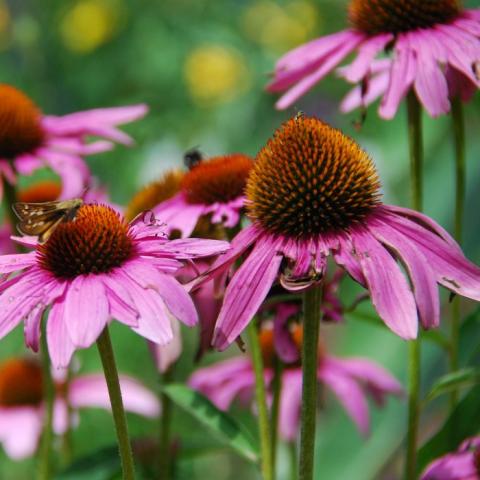Wildlife & Water Friendly Gardens | Workshop series

Last updated 2 March 2024.
Organised by the John Inskeep Environmental Learning Center (ELC) at Clackamas Community College.
Learn to modify your gardening practices to benefit and attract wildlife, all while protecting the health of our watersheds.
The Environmental Learning Center presents a FREE Workshop Series for anyone interested in home gardening for wildlife and water quality. Learn how to garden with less water, manage too much stormwater, and generally provide a healthier habitat for birds, pollinating insects, and more.
Sign up for one or all of the courses below! Thursdays, January 25 - March 7 2024, 13:00 PST.
Schedule of Programs
Each week, experts will share their experience, stories, best practices, and expertise with you. There will be plenty of time for discussion, so come prepared with your garden questions!
January 25 - Connecting the Pieces of our Urban Ecosystems
Presented by: Lori Hennings, Metro Conservation Program, Parks and Nature Department
Wildlife corridors have long been recognized as essential for sustaining populations in an increasingly fragmented environment. Learn more about the role we can play in helping wildlife to find a way to our own backyards and how this impacts the bigger picture for wildlife and watershed health.
You might also be interested in IPBES's upcoming assessment on biodiversity-inclusive spatial planning and ecological connectivity. Join ONet and the Stakeholder Registry to stay up to date on associated opportunities.
February 1 - Take a Walk on the Wild Side: The remarkable wild bees of Oregon (and how to welcome them to your backyard)
Presented by: Andony Melathopoulos, Oregon State University Associate Professor in Pollinator Health Extension in the Department of Horticulture
The number of bees continues to creep up. First, we had a card that said, “500 species”. Then, when no one was looking, we upped the number to 600 species. Now we say “782 species”. The reason for the ever-increasing number are the remarkable counterpart to the Master Gardeners, the Master Melittologists. Take a walk on the wild side with these volunteers as we show you the unbelievably weird bees of the state, the flowers they love and tips on how to welcome this biodiversity into your backyard.
You might also be interested in IPBES's very first assessment report and its summary for policymakers: the report addressed pollinators, pollination and food production. While the report raised global awareness of human impact on pollinators at the time of its publication, its findings remain urgent and efforts to protect pollinators are ongoing.
February 8 - Garden Smart for the Changing Climate
Presented by: Amy Whitworth, Plan-it Earth Design, Earth Friendly Garden Designer & Community Educator
In the Pacific Northwest we are always trying to find the balance between our long rainy season and our dry summers. With climate change, rains are getting heavier and summers are getting hotter. Both put undo strain on our watersheds. Learn strategies to successfully manage both in your garden.
You might also be interested in IPBES and IPCC's joint work on biodiversity and climate change.
February 15 - Friend or Foe? How to Identify Invasive Plants in Our Backyards
Presented by - Sam Leininger, Clackamas County SWCD
Learn how to identify some of the biggest plant threats in your backyard. Some invasive plants can rapidly overwhelm natives and negatively impact ecosystem health. Some of these villains are considered noxious weeds. We can help to eradicate them by recognizing them before they take over.
You might also be interested in IPBES's most recent assessment report on invasive alien species. For an overview of IPBES publications, materials, and projects on invasive alien species, see our dedicated page.
February 22 - Companion Planting for Clean Water
Presented by - Lydia Cox, Landscape Designer and Garden Coach
Companion planting can work by protecting and shielding crops, improving pollination, trapping and luring pests, repelling pests, and enriching the soil, a win-win for crop yield and native species.
Learn from an expert in the field to understand how companion crops work together to tackle common garden problems, reduce reliance on pesticides, and increase biodiversity.
You might also be interested in the upcoming IPBES Nexus assessment of the interlinkages among biodiversity, water, food and health. IPBES is expecting to publish it by the end of 2024: join ONet to stay tuned.
February 29 - Plants and Fungal Networks
Presented by – Claudia Groth, OSU Extension Service Master Gardener™ Volunteer
More than 90% of all plant species form associations with mycorrhizal fungi which enables them to “extend” their root systems to access water and chemical information from further afield. This network reaps many mutual benefits for plants and fungi that include increased drought resistance. As we strive to garden with less water, could these fungal networks be part of the solution?
March 7 - What Tree Should I Plant?
Presented by - Drew Zwart, Ph.D, Research Scientist - Plant Pathology & Physiology, Bartlett Tree Experts
Plant a tree! What are the factors to consider in selection, placement, and care to promote a successful outcome and provide benefits to both overheated gardeners and wildlife alike? Which trees thrive in residential landscapes? We will explore a variety of trees in this presentation.
If you have questions about this series, please e-mail: [email protected]
About the John Inskeep Environmental Learning Center (ELC)
The John Inskeep Environmental Learning Center (ELC) has a rich history as an educational resource for Clackamas Community College, regional schools, industry and the community. Located on the former site of a Smucker's processing plant, the center was created to demonstrate what people could do to reclaim industrial sites, address stormwater issues and restore wildlife habitats in urban areas. Thousands of people visit to explore the 5-acre site and learn about watershed health each year. The site serves as an essential stormwater facility for the college campus. It provides a critical wetland habitat for resident and migratory birds, such as the great blue heron, wood duck and merganser.
Photo by UD Cooperative Extension on Flickr: Purple coneflowers (Echinacea purpurea) are native to North America and attractive to many pollinators. A number of Echinacae species are also used by indigenous peoples in traditional medicine.
